#contaminated soil waste
Explore tagged Tumblr posts
Text
Safeguarding Your Site with Expert Contaminated Soil Removal Services: A Comprehensive Guide
Professional contaminated soil waste removal services provide a safe and efficient way to remove hazardous materials from a property. Using specialized containment vehicles, experienced personnel, and the proper regulations and procedures, they can help ensure that local and federal guidelines safely dispose of the contaminated soil.
0 notes
Text
"An environmental toxicologist in California is cleaning up areas contaminated with heavy metals or other pollutants using fungi and native plants in a win-win for nature.
Where once toxic soils in industrial lots sat bare or weed-ridden, there are now flowering meadows of plants and mushrooms, frequented by birds and pollinators: and it’s thanks to Danielle Stevenson.
Founder of DIY Fungi, the 37-year-old ecologist from UC Riverside recently spoke with Yale Press about her ongoing work restoring ‘brownfields,’ a term that describes a contaminated environment, abandoned by industrial, extraction, or transportation operations.
A brownfield could be an old railway yard or the grounds of an abandoned oil refinery, but the uniting factor is the presence of a toxic containment, whether that’s a petrochemical, heavy metal, or something else.
Noting that she had read studies about mushrooms growing around the Chernobyl nuclear plant, she came to understand further, through her work, that fungi are an extraordinarily resilient species of life that consume carbon, and even though petroleum products are toxic to plants, to mushrooms they are essentially a kind of carbon.
In fact, mushrooms break down several categories of toxic waste with the same enzymes they use to consume a dead tree. They can also eat plastic and other things made out of oil, like agrochemicals.
At the Los Angeles railyard, as part of a pilot project, Stevenson and colleagues planted a variety of native grass and flower species alongside dead wood that would incubate specific fungi species called arbuscular mycorrhizal fungi, which assists plants in extracting heavy metals like lead and arsenic from the soil.
Alongside traditional decomposer fungi, the mixture of life forms demonstrated tremendous results in this brownfield.
“In three months we saw a more than 50 percent reduction in all pollutants. By 12 months, they were pretty much not detectable,” Stevenson told Yale 360.
Decontaminating soil like this typically involves bringing in a bulldozer and digging it all up for transportation to a landfill. This method is not only hugely expensive, but also dangerous, as contaminated material can scatter on the winds and fall out of the backs of trucks carting it away.
By contrast, the plants that draw out the toxic metals can be harvested and incinerated down to a small pile of ash before cheap transportation to a hazardous waste facility.
The technique, which Stevenson says has some scaling issues and issues with approval from regulators, is known officially as bioremediation, and she’s even used it to safely break down bags of lubricant-soaked rags from bicycle repair shops.
“People who live in a place impacted by pollution need to have a say in how their neighborhood is being cleaned up. We need to empower them with the tools to do this,” she said."
-via Good News Network, July 16, 2024
#mushrooms#fungi#mycology#mushroom#contamination#bioremediation#hazardous waste#hazardous materials#soil#mining#heavy metals#good news#hope#ecopunk#solarpunk
1K notes
·
View notes
Text
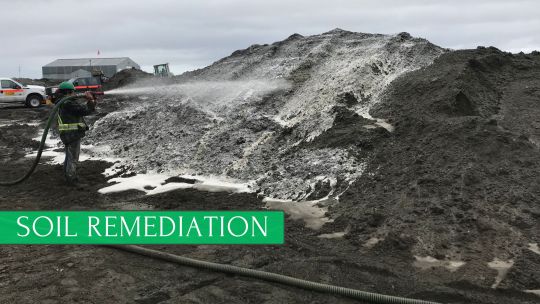
Unearthing the Power of Soil Remediation: A Promising Path towards Environmental Sustainability
The health of our planet is intricately linked to the quality of its soil, an aspect that is often overlooked. Soil pollution presents a significant environmental concern, affecting agricultural productivity, water quality, and ultimately, human health. However, the innovative field of soil remediation holds the key to reclaiming contaminated land and fostering a sustainable future.
Soil remediation, a sector of environmental science, focuses on purifying and revitalizing the soil. It encompasses various techniques to remove harmful pollutants, such as heavy metals, petroleum products, pesticides, and more, from contaminated soil. The ultimate aim is to restore the soil to a state where it can once again support healthy growth and biodiversity.
There are several methods of soil remediation, each tailored to the type and extent of soil contamination.
1. Excavation and Disposal
As a direct approach, this method involves physically removing the contaminated soil and disposing of it in designated landfills. Although it's an immediate solution, it merely transfers the contamination issue from one place to another, leading to concerns about its environmental sustainability.
2. Soil Washing
This technique uses water, sometimes mixed with other substances, to wash away contaminants. It's particularly effective for treating soils contaminated with heavy metals or certain kinds of organic pollutants. However, the process requires treatment of the resulting washwater to avoid secondary contamination.
3. Bioremediation
One of the most promising soil remediation strategies, bioremediation, employs natural processes to clean up contaminated soil. Specific microorganisms or plants (phytoremediation) are used to absorb, break down, or immobilize contaminants. This method is eco-friendly and holds great potential for large-scale applications.
4. Thermal Desorption
Thermal desorption involves heating soil to evaporate the pollutants, which are then collected and treated separately. This process is ideal for soils contaminated with volatile organic compounds, but it requires substantial energy input.
Soil remediation's significance extends far beyond environmental preservation. Healthy soil is critical for a functioning ecosystem, contributing to plant growth, water filtration, and climate regulation. Moreover, with the escalating global population, the need for arable land is at an all-time high. Through soil remediation, previously unusable land can be restored, strengthening food security and promoting sustainable land use.
Simultaneously, soil remediation helps protect groundwater resources. Soil acts as a natural filter, and contaminants present in the soil can leach into groundwater over time, posing serious health risks. By removing these pollutants, soil remediation safeguards our water supply.
In the grand scheme of climate change, soil remediation plays a pivotal role. Soil holds three times as much carbon as the atmosphere. Techniques like bioremediation not only remove contaminants but also improve soil health, increasing its capacity to store carbon and thereby helping to mitigate climate change.
In conclusion, soil remediation is not merely a sector of environmental science; it is a tool of hope for our planet. It embodies the mantra of "heal the soil, heal the planet," and underscores our responsibility to protect the environment. With continued research and technological advancements in soil remediation techniques, we can make strides towards a sustainable future.
Let's invest in soil remediation - for our health, for our food, and for our planet.
#Soil Remediation Techniques#Methods of Soil Remediation#Importance of Soil Remediation#Biological Soil Remediation#Chemical Soil Remediation#Thermal Soil Remediation#Soil Contamination Solutions#Future of Soil Remediation#Nanoremediation for Soil#Prevention of Soil Pollution#Soil Degradation and Remediation#Phytoremediation Techniques#Environmental Restoration Techniques#Soil Clean-up Methods#Soil Sustainability Practices#Eco-friendly Soil Remediation#Industrial Waste Soil Remediation#Soil Remediation Technologies#Innovations in Soil Remediation#Impact of Soil Remediation
2 notes
·
View notes
Text
I included some highlights from the article here, but I highly recommend reading this whole thing.
We hear so much about how wildfires that move into towns or cities devastate communities--but once the blazes have finally been extinguished the news usually moves on to the next crisis and we don't get to hear about how these communities and outside helpers rally together to rebuild afterwards. Including regrowing the trees and gardens that help provide shade and food security to neighborhoods.
From the article:
"The Altadena Seed Library, a network of seed exchange boxes, is leading the charge. Raj’s project began in 2021, with several little seed libraries stationed around the community. Seed libraries mimic regular libraries, but instead of books, people check out (and use) envelopes of seeds for free. Now, Raj and other volunteers are working on a game plan for regrowing the lawns, gardens, and urban green spaces that combat shade inequity and increase food sovereignty in their neighborhood — and looking to learn from other communities that have also seen their landscapes drastically altered by destructive wildfires. Donated seeds and tools are pouring in from locals and places around the country, as well as compost, pots, trees, and personal protective equipment for people cleaning up the hazardous waste leftover from burned homes and melted cars. “We’ve had a pretty overwhelming response,” Raj said. “People have been so, so generous.” Individual volunteers and organizations like Club Gay Gardens, a nonprofit in nearby Glendale, are helping sort the donated seeds. [...] Replanting efforts in Paradise, California, where the Camp Fire killed 85 people in 2018, and Lahaina, Hawai‘i, where a wildfire killed 102 people in 2023, offer inspiration as to what responsible reseeding can look like post-fire. Wildfire survivors from up and down the West Coast have already reached out to Raj, offering to help Altadena. “It’s so unfortunate to be bonded in that way,” Raj said. “It also feels really beautiful that those connections can grow out of something so tragic.” The Federal Emergency Management Agency helped test for soil toxicity in Paradise, eventually scraping the contaminated top layers away. But replanting efforts were left to residents. “None of this would have happened if it weren’t for these community groups that all came together,” said Jennifer Peterson, a Paradise local who saw her house, plus a seed library and two community gardens she worked on, destroyed. Peterson and other community members worked hard to safely reestablish old food sources. In 2020, several groups and 300 volunteers joined forces to rebuild — in one day — a nonprofit arts and culture center whose public gardens provide compost, seeds, and produce for free. Grant money allowed organizations like the Butte County Local Food Network to prepare 150 garden boxes and deliver them to people’s homes, complete with new soil and plants. Being part of efforts to regrow people’s food — and her front yard, which now teems with native wildflowers whose seeds survived the fire — has helped Peterson heal. “It was kind of like therapy for everybody,” she said. In Lahaina, on Maui, where an estimated 150,000 trees burned, replanting efforts so far have focused on fruit trees that will eventually provide food and shade again, said Duane Sparkman, chair of the Maui County Arborist Committee and cofounder of Treecovery Hawaii, a nonprofit focused on replanting Lahaina. So far, Treecovery Hawaii has raised half a million dollars to purchase trees at full price from local nurseries and give them to families who are rebuilding. The organization has established several hubs to grow more trees, and Sparkman said he’d like to buy a larger nursery space on central Maui. A detailed planting plan created by Maui County lays out what types of trees should get planted on the island, as well as the care they need. Over 200 trees have been planted or are in pots on-site, ready to be put in the ground. That includes a mouthwatering array of fruit trees — mango, jackfruit, starfruit, avocado, citrus, and banana — fragrant plumeria and orchid trees, and native species like wiliwili, milo, koa, and lauhala trees. “Knowing that we’re going to be part of what’s eventually going to be the canopy for our grandchildren is immense for us,” Sparkman said."
#wildfire#wildfire rebuilding#climate change#global warming#hope#hopepunk#solarpunk#gardening#food security#climate resilience#widlfire recovery#community#food garden#environment#ecology#food sovereignty
206 notes
·
View notes
Text
The full extent of the damage in Gaza has not yet been documented, but analysis of satellite imagery provided to the Guardian shows the destruction of about 38-48% of tree cover and farmland. Olive groves and farms have been reduced to packed earth; soil and groundwater have been contaminated by munitions and toxins; the sea is choked with sewage and waste; the air polluted by smoke and particulate matter. Researchers and environmental organisations say the destruction will have enormous effects on Gaza’s ecosystems and biodiversity. The scale and potential long-term impact of the damage have led to calls for it to be regarded as “ecocide” and investigated as a possible war crime.
[...]
He Yin, an assistant professor of geography at Kent State University in the US, who studied the damage to agricultural land in Syria during the 2011 civil war, analysed satellite imagery showing that up to 48% of Gaza’s tree cover had been lost or damaged between 7 October and 21 March. As well as direct destruction from the military onslaught, the lack of fuel has led to people in Gaza having to cut down trees wherever they can find them to burn for cooking or heating. “It’s whole orchards gone, only soil left; you don’t see a single thing,” Yin says. Independent satellite analysis by Forensic Architecture (FA), a London-based research group that investigates state violence, found similar results. Before 7 October, farms and orchards covered about 170 sq km (65 sq miles), or 47% of Gaza’s total land area. By the end of February, FA estimates from satellite data that Israeli military activity had destroyed more than 65 sq km, or 38% of that land. As well as cultivated land, more than 7,500 greenhouses formed a vital part of the territory’s agricultural infrastructure. Almost a third have been destroyed entirely, according to FA’s analysis, ranging from up to 90% in the north of Gaza to about 40% around Khan Younis.
514 notes
·
View notes
Text
Started the day by reading this article from the NY times, and I'm frankly, disturbed.
Some highlights:
"For decades, farmers across America have been encouraged by the federal government to spread municipal sewage on millions of acres of farmland as fertilizer. It was rich in nutrients, and it helped keep the sludge out of landfills."
Which I knew, and I knew that there were concerns about contaminants from like, the medications people were on. But human waste is part of the nutrient cycle, and it always made sense to me that it should be throughly composted and returned to agricultural lands, and I assumed that people in general were taking the steps necessary to make it safe.
But here's what I didn't know:
"The 1972 Clean Water Act had required industrial plants to start sending their wastewater to treatment plants instead of releasing it into rivers and streams, which was a win for the environment but also produced vast new quantities of sludge that had to go somewhere."
Which, yay, no longer polluting bodies of water, but now that means we're applying industrial waste water to agricultural lands. And have been since 1972. Which leads to this situation, among many others, I'm sure:
"The sludge that allegedly contaminated the Colemans’ farm came from the City of Fort Worth water district, which treats sewage from more than 1.2 million people, city records show. Its facility also accepts effluent from industries including aerospace, defense, oil and gas, and auto manufacturing. Synagro takes the sludge and treats it (though not for PFAS, as it’s not required by law) then distributes it as fertilizer."
So here's what some states are doing:
"In Michigan, among the first states to investigate the chemicals in sludge fertilizer, officials shut down one farm where tests found particularly high concentrations in the soil and in cattle that grazed on the land. This year, the state prohibited the property from ever again being used for agriculture. Michigan hasn’t conducted widespread testing at other farms, partly out of concern for the economic effects on its agriculture industry.
In 2022, Maine banned the use of sewage sludge on agricultural fields. It was the first state to do so and is the only state to systematically test farms for the chemicals. Investigators have found contamination on at least 68 of the more than 100 farms checked so far, with some 1,000 sites still to be tested.
“Investigating PFAS is like opening Pandora’s box,” said Nancy McBrady, deputy commissioner of Maine’s Department of Agriculture."
This is fun:
"The E.P.A. is currently studying the risks posed by PFAS in sludge fertilizer (which the industry calls biosolids) to determine if new rules are necessary.
The agency continues to promote its use on cropland, though elsewhere it has started to take action. In April, it ordered utilities to slash PFAS levels in drinking water to near zero and designated two types of the chemical as hazardous substances that must be cleaned up by polluters. The agency now says there is no safe level of PFAS for humans...
It’s difficult to know how much fertilizer sludge is used nationwide, and E.P.A. data is incomplete. The fertilizer industry says more than 2 million dry tons were used on 4.6 million acres of farmland in 2018. And it estimates that farmers have obtained permits to use sewage sludge on nearly 70 million acres, or about a fifth of all U.S. agricultural land."
There's more, but I wanted to condense it at least a little bit. I am glad we're raising awareness, and I'm glad we're starting to regular the amount in our drinking water, and I hope that we'll find a way to actually deal with PFAS. I am so frustrated that people are exposed in the first place, and in nigh inescapable ways.
Also, to all those people who were like, oh, organic isn't at all healthier for consumers? Guess what the organic standards don't allow to be applied?
140 notes
·
View notes
Text

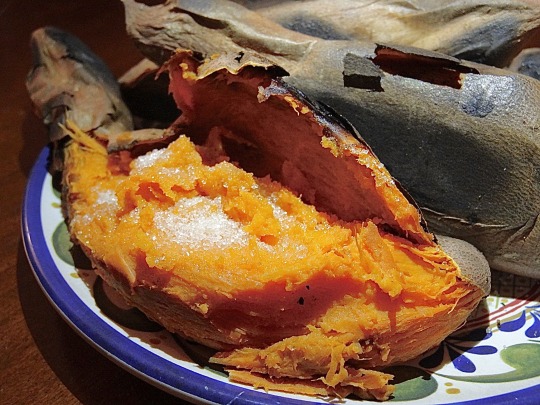
[ID: Sweet potatoes with black, charred skin on a decorative plate. One has been opened to show bright orange flesh, sprinkled with sugar. End ID]
بطاطا حلوة مشوية / Batata hiluwa mashwiyya (Roasted sweet potatoes)
Sweet potatoes are considered a traditional and nostalgic food in Palestine—a gift from the land, a seasonal delicacy, a potentially profitable crop, "red gold." Every fall and winter, as they are grilled in taboon ovens throughout Gaza, their smell fills the air.
This recipe uses a method of preparation common in rural Palestine, which applies direct heat to char the potatoes; the black, crackly skin is then peeled off, leaving tender, steaming, sweet flesh with a roasted aroma. The peeled sweet potato is eaten on its own, or sprinkled with sugar.
The recent history of sweet potatoes in Gaza is a microcosm of Israel's economic control of the region during that time. Though they grow well in Gaza's soil, they are a risky commitment for its farmers, as the seeds or seedlings must be imported from Israel at considerable expense (about 40 shekels, or $10, per plantlet), and they need to be weeded every day and irrigated every other day. Water for irrigation is scarce in Gaza, as Israel drains and contaminates much of the supply.
Nevertheless, the crop would be a profitable one if Gazan farmers were allowed to export it. In the shmita year of 2014, for the first time since the Israeli military's deadly 51-day invasion two months prior, restrictions briefly eased to allow Gazans to export some agricultural products to Europe; the first shipment contained 30 tons of sweet potatoes. However, an estimated 90% of the sweet potato crop was at that time unsuitable for export, having been damaged by Israeli shrapnel. The Gazan Ministry of Agriculture estimated that damages of this kind cost the agricultural sector about 550 million USD during this year.
Gazan economist Maher al-Taba’a holds that Israel temporarily allowing export of a token amount of sweet potatoes “is nothing more than media propaganda which is meant to confuse international audiences" by giving the impression that the siege on Gaza was looser than it had been before the 2014 ceasefire agreement; meanwhile, the number of allowed exports had actually decreased since before the invasion occurred. Gazan farmers, in fact, were not even allowed to export produce to Palestinians in the West Bank until 2017.
The next shmita year (an agricultural sabbath during which ultra-Orthodox Jews allow their fields to lie fallow) began in September of 2021, around the same time as the beginning of the sweet potato harvest. In anticipation of the shmita year, and in keeping with the trickle of Gazan exports that had been allowed into Israel in the intervening years, many farmers had planted more than they otherwise would have. But Israel delayed accepting the imports, leading many farmers to throw away rotting produce, or to sell their produce in the local market for far lower prices than they had been expecting.
Israel's habit of closing off Gaza's exports arbitrarily and without notice recurred during the harvest season of 2022. When Israeli former MK Yaakov Litzman called on Minister of Agriculture and Rural Development Oded Forer to import sweet potatoes from Gaza due to a shortage of the produce in Israel, Forer refused, citing Israeli soldiers whom Palestinian resistance fighters had taken hostage as rationale for his decision. Other officials were surprised at the linking of an agricultural matter to a political one.
Farmers had no choice but to enter the harvest season hoping that the decision would be reversed and that their time, labor, money, and scarce water resources would not go to waste. With these last-minute decisions that cause Gazan farmers to be unable to fulfill their contracts, Israel damages the future viability of Gazan exports to European markets.
Support Palestinian resistance by calling Elbit System’s (Israel’s primary weapons manufacturer) landlord and donating to Palestine Action’s bail fund.
Equipment:
A fire, wood-burning oven, gas stove, or broiler
A baking sheet
Ingredients:
Sweet potatoes. Choose a variety with red or orange skin and orange flesh, such as garnet or jewel.
Sugar, cinnamon, date syrup, or tahina, to serve.
Instructions:
1. Wash sweet potatoes. Place them at the bottom of a taboon oven, or on a baking sheet or griddle laid over a cooking fire or gas burner. You may also place them on a baking sheet or cast-iron pan inside an oven with a broiler setting.

2. Turn the gas burner on medium-high, or the broiler on low. Heat the sweet potatoes, occasionally rotating them, until their skin is blistered and blackened in multiple places and they are tender all the way through.
3. Remove potatoes and allow them to cool slightly. Slice each potato open lengthwise, or peel away its skin, and eat the interior.
Roasted sweet potatoes may be eaten on their own, or sprinkled with sugar or cinnamon-sugar, or drizzled with date syrup, tahina, chocolate sauce, etc.
367 notes
·
View notes
Note
i’m taking a construction course which has a module on waste management, so i now know depending on how old the house is, there are a load of different contaminants which could be floating about and have probably ruined the soil (rip fiona’s plants). according to my revision sheet, some of them could be:
- heavy metals (lead pipes, old plumbing, arsenic-treated wood)
- volatile organic compounds like solvents, alcohols, and formaldehyde, (paint thinners, varnishes, wood + wallpaper chemical treatments)
- asbestos (literally everything that needed to be fireproof or insulating, ie tiles, plaster, pipes, insulation, flooring, etc)
- polychlorinated biphenyls which are pollutive but can also affect your immune and reproductive systems (early elec systems, paints and varnishes)
- technically pesticides but i personally doubt they’d be allowed within a ten mile radius of the house
- creosote + wood preservatives, carcinogenic and also toxic to plants, sorry fiona (railway ties, treated beams and floorboards)
- chlorinated solvents (early cleaning products and degreasing agents)
- i cannot overstate the investment of lead all of those kids have heavy metal poisoning in some way. my notes specifically note ‘neurological damage especially in children’
- coal dust and soot (fireplaces)
in conclusion the reason the ruins were still there when jacob arrived was because nobody was investing to remediate a deeply contaminated brownfield site in the middle of nowhere, and it’s a miracle they didn’t die from the toxicity of everything around them before they made it to london
These children are ticking time bombs in more ways than one and they are so incredibly lucky they did not just immediately die anytime they left the loop oh my god
21 notes
·
View notes
Text

Facts and Theories related to Fool's Gold and Norton
Part 1: Facts and Theories about Pyrite aka Fool's Gold
TLDR - Facts:
comes from the Greek word for fire
the dangers of pyrite oxidation (sulfuric acid, sulfur dioxide)
pyrite can contain small amounts of real gold, called “invisible gold”
TLDR - Theories
Pyrite containing real gold parallel to Norton being good deep down
Fire connection to Infernal Sin
Pollution in Lakeside water and soil as well as cause of fish and plants dying because of Golden Cave?
Part 2: Facts and Theories about how Norton escaped Golden Cave
TLDR:
Norton didn't just simply dig himself out
Facts about mines, mine collapses, dangers, potential escape routes, etc...
Part 1
Facts
Pyrite (aka fool’s gold) comes from the Greek word ‘pyros’ meaning ‘fire’, and will create sparks when struck against metal or a hard surface.
It is capable of scratching glass while most knives won’t be able to scratch it.
In the presence of moisture and oxygen, pyrite oxidizes, releasing its sulfur content as sulfuric acid.
Pyrite rich waste from mining operations can increase acidity of surface water. This can harm downstream ecosystems, animals, and even pose a risk to humans.
Sulfur dioxide is produced by burning the pyrite in coal, which can combine with moisture in the atmosphere to create acid rain.
Pyrite oxidation is sufficiently exothermic enough to produce heat, and as the temperature rises, the coal heats up and in some cases cause it to self-ignite and cause fire. This is called spontaneous combustion, a very real problem in coal mines. Pyrite dust can burn even with only a little oxygen, and it burns well due to its sulfur content. Sulfide fires can burn for years.
Despite its reputation, pyrite can sometimes contain small amounts of real gold, although it is notoriously hard to extract. This gold is sometimes referred to as “invisible gold” because it isn’t observable by the naked eye or standard microscopes (you need sophisticated scientific instruments). It can come in different forms: either as particles of gold, an alloy where the pyrite and gold are finely mixed, and in defects (imperfections created when the pyrite crystals are forming) in the crystal structure . With the latter form, the more deformed it is, the more gold there is in the defects.
And the discovery of new gold deposits declining world wide, with the quality of ore degrading in parallel to the value of precious metal increasing.
Invisible gold is primarily found in pyrite and arsenopyrite, and this is now a common resource for the gold mining industry.
Theories
I really wanted to bring up pyrite having some real gold (even if the amounts are very small). Especially as I can draw a parallel with that to Norton, who may normally seem suspicious, but he isn’t entirely bad. He may seem unapproachable, but you may make progress if you dig deep enough and try hard enough. He isn’t completely “worthless”.
Pyrite coming from the word for fire connects well to Infernal Sin, while pyrite being a fire starter in the fast due to its ability to create sparks fits well with Norton’s how we see Norton causing the explosion in Golden Cave in his trailer.
Then regarding the sulfuric acid, this actually made me wonder if the contamination in Lakeside, revealed in Yidhra’s letters, could be related to or from Golden Cave.

Ground water is water that seeps into the ground via rain or snow melt. As it makes its way underground, it can collect or react to the minerals and rocks down there, including pyrite, which can eventually result in the oxidation (and all its problems) I described earlier. This can percolate to form sediment at the bottom of rivers with mine drainage, which is water drained from mines. Acid runoff further dissolved heavy metals into water, and acid mine drainage can be increased by the action of certain bacteria (aka, sulfuric acid from pyrite can leech heavy metals from rock, and the acid can be worsened by bacterial action, resulting in this drainage becoming highly toxic).
Problems with mine drainage include contaminated drinking water, disrupted growth and reproduction of plants and animals, and corroding effects of acid on structures.
In general, sulfide rich and carbonate poor materials produce acid drainage. In contrast, alkaline rich materials, even with significant sulfide concentrations, often produce alkaline conditions in water.
Abandoned mines can fill with water (flood) because there’s no pumping occurring (the steam engine was 1st invented to solve mine flooding). This results in unabated chemical reactions, potentially making it very toxic, and this water can even discharge into lakes and streams, killing aquatic life and polluting the environment.
Further acid drainage can result from waste rock, which is material that must be removed to reach the ore. It is often deposited in piles close to the mine, and as it is exposed to air and moisture, it causes weathering, which can generate acid drainage.
Yidhra’s 3rd letter does mention “microbial deposits” in the water and soil as well as the soil’s “acidity and alkalinity”. So maybe it could be connected…?
Part 2
Thoughts regarding specifically how Norton escaped Golden Cave
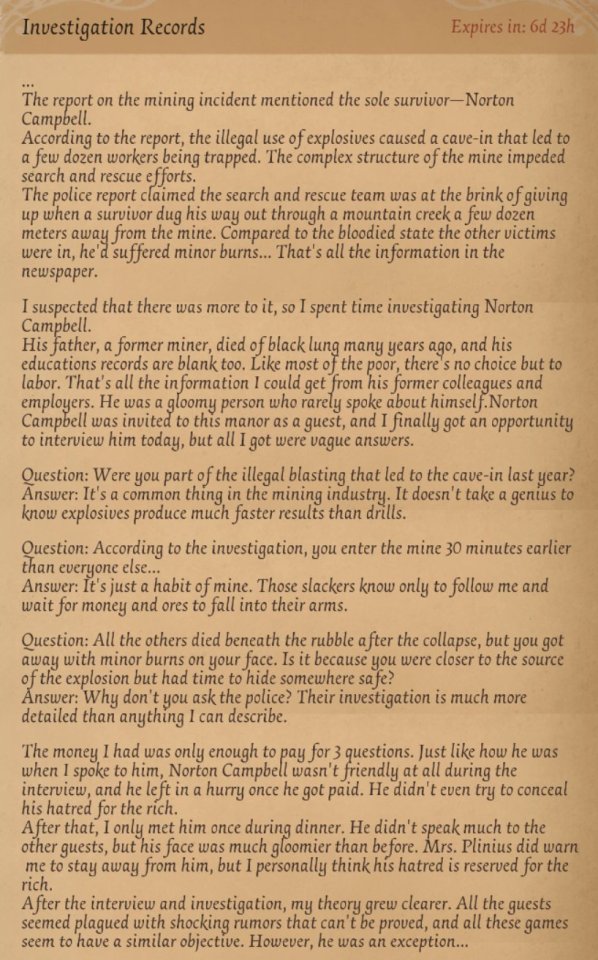
Norton’s 3rd letter states the police report claimed Norton “dug his way out through a mountain creek a few dozen meters away from the mine”.
It is unlikely Norton simply dug himself out from the mine.
Golden Cave’s backstory states it was “hundreds of meters” deep at least. Mines back in that day (late 19th century) were already 1000s of feet deep (1 was 700-900m = 2300 – 3000ft). Prior to the 1850s, miners could simply walk in to a mine to get where they needed to go, but later on, the mines became so deep, they had to use steam elevators to enable access to deeper seems.

We know Norton was trapped in Golden Cave for some time after the mine collapse considering we know he came out with meteorite chunks. Based on what we see on the lowest level of Golden Cave in game, this likely implies the meteorite was potentially at the bottom, meaning there’d be quite some distance to dig himself out.
The other issue is most miners don’t simply dig themselves out after a collapse. There’s nothing to support the roof and sometimes little space to put the material you remove, not to mention usually a lack of suitable tools. Trying to dig yourself out of a collapsed mine may even weaken the area near the collapse, potentially causing further collapses. This is why most miners usually have to wait to be rescued.
It is possible that Norton was able to access an alternate escape route. Mines were required to have more than 1 shaft following the Hartley mine disaster in 1862. If it or a raise (vertical or inclined passage) had a safety ladder, it’s possible he could work his way back up. During the Barnes-Hecker mine disaster (the mine was flooded), the sole survivor saved himself by climbed 80 stories (around 800 feet) in just about 14 minutes.
Another option is via an intake airway (or downcast shaft), which brings fresh air from the surface into the underground mine. Miners could feel the air to figure out a way out of the mine, and this was breathable air, free from fumes and dust in the case of a fire or explosion. A return airway (upcast shaft) is also an option, but not as nice of one due to the fact it carried air out of the mine to the surface, and this air could include dust, toxic fumes, and such. But miners have escaped via vents before (such as in the Quecreek Mine disaster, which they did to escape the mine as it started flooding).
And if acid mine drainage is potentially related to the pollution and dead animals/plants in Lakeside (Yidhra’s 3rd letter, Grace trailer/deductions), maybe that means there was drainage or some other hole into or out of the mine around there that Norton could’ve used to escape. Norton’s deduction 9 does make it sound like police didn’t expect anyone to survive, which could imply the normal entrances or exits were inaccessible following the collapse, meaning using an alternate, less known route might make sense. We know Norton was knowledgeable, and in the trailer we see him with a map, though based on how his coworkers in that scene look like they might take it from him, he might not have had that, but he may have at least memorized the different ways in and out, and thus how he could manage to escape (especially as explosions can damage the lifts they use to normally get down to the deeper levels).

Norton likely survived due to being some distance from the blast. Some of his coworkers likely died from the initial explosion. The others potentially could’ve succumbed to lack of oxygen, potentially aided if any fires started as a result (which could further weaken supports or cause more collapses), or due to potentially high concentrations of firedamp further down. Afterdamp (choking gas) is a mix of toxic gases (carbon dioxide, carbon monoxide, and nitrogen) after a methane explosion, and it is just as deadly as the actual explosion. Symptoms include head swimming/disorientation, feeling very tired, difficulty doing anything or exerting yourself, and a desire to just close your eyes and go to sleep (followed soon by death from the lack of oxygen).
#idv#identity v#norton campbell#prospector#idv norton#identity v norton#idv prospector#identity v prospector#Fool's Gold#hunter norton#idv fool's gold#idv hunter norton#identity v fool's gold#identity v hunter Norton#sirenjose analyses and theories
78 notes
·
View notes
Text
Researchers have developed a new optical sensor that provides a simple way to achieve real-time detection of extremely low levels of arsenic in water. The technology could enable household testing for arsenic, empowering individuals to monitor their own water quality. Arsenic contamination is a serious environmental and public health challenge affecting millions of people around the world. This contamination occurs when natural geological processes release arsenic from rocks and soil into groundwater and can be exacerbated by mining, industrial waste disposal and use of arsenic-based pesticides. "Consuming arsenic-contaminated water can lead to severe health conditions including arsenic poisoning and cancers of the skin, lung, kidney and bladder," said lead researcher Sunil Khijwania from the Indian Institute of Technology Guwahati. "By creating a sensor that is sensitive, selective, reusable and cost-effective, we aim to address the need for a reliable and user-friendly tool for routine monitoring, helping to protect communities from the risks of arsenic exposure."
Read more.
#Materials Science#Science#Sensors#Optics#Arsenic#Clean water#Water#Gold#Alumina#Composites#Graphene#Nanotechnology#Fiber optics
16 notes
·
View notes
Text
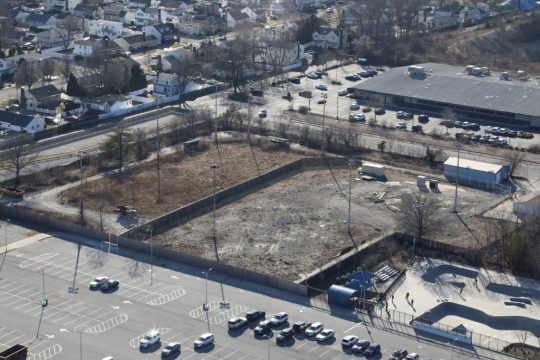
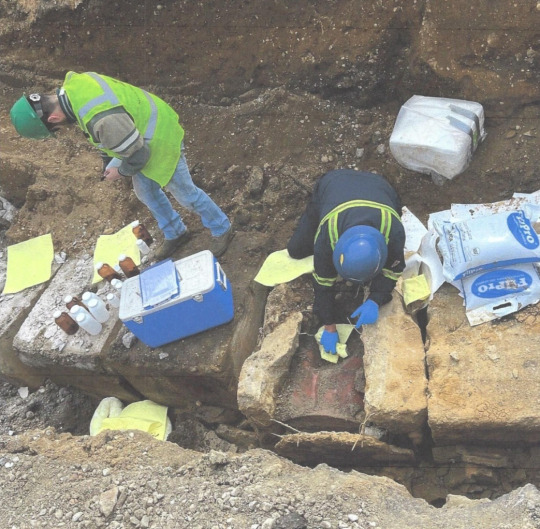
🇺🇲 🚨
SIX DRUMS FILLED WITH TOXIC CHEMICALS DEPOSITED BY NORTHROP GRUMMAN FOUND BURIED IN CANCER-PLAGUED LONG ISLAND TOWN
📹 Six 55-gallon drums filled with toxic chemicals, and encased in concrete coffins, some broken, were found buried under Bethpage Community Park in cancer-plagued Bethpage, a town on Long Island in New York State, which was deposited by U.S. military contractor Northrop Grumman.
Previously, the town of Bethpage had to contend with a 6-square mile toxic plume of hazardous waste resulting from Northrop Grumman's dumping of chemicals underground in the area.
At least one of the 55-gallon drums was found punctured, and some contained flammable chemicals.
The drums were found buried just 4-feet underground, underneath the Park's baseball field which was previously abandoned more than 20 years ago due to concerns over soil contamination.
According to a report in New York Post, a layer of clay was found under the drums, where authorities believe chemicals could have seeped into the ground.
Oyster Bay Supervisor, Joseph Saladino, called on authorities with New York's Department of Environmental Conservation (DEC) to clean up the park by collecting all the contaminated soil and removing it from Long Island. The community's tax payers previously paid $20 million to clean up the site to allow local residents to use the Park's skating rink.
Saladino also filed a lawsuit against Northrup Grumman 10 years ago to reimburse the community's costs for the cleanup, while a new lawsuit was filed in December to order the further cleanup and removal of the toxic soil.
Local residents have been complaining of higher cancer rates in their community for years, arguing that surrounding communities have far lower rates to their own, while the DEC claimed the discovery posed "no immediate threat to public health."
Still, local residents say they're fed-up, continueing to call for the immediate removal of toxic substances, along with demands for a full soil excavation in the park.
“I’ve had it. I’ve had it. I’ve been working on this for over 20 years as a New York state Assembly member and now as the supervisor of the fourth-largest town in America and I’m not going to sit by idly,” Saladino is quoted as saying.
Northrop Grumman, for its part, said it continues to work with the DEC to address the situation.
#source
@WorkerSolidarityNews
#bethpage#bethpage community park#long island#new york#united states#us news#new york news#us politics#northrop grumman#us military contractors#us military#politics#news#geopolitics#world news#global news#international news#breaking news#current events#ny news#polution#toxic dumping#military production#military contractors#illegal dumping#cancer#corporate criminality#corporate crime#crime
38 notes
·
View notes
Text
The new 'compost obligatoire' rules came into force on 1 January 2024. Here's what they entail.
As of 1 January 2024, organic waste recycling is mandatory in France under new 'compost obligatoire' rules.
With support from the government’s Green Fund, municipalities must provide residents with ways to sort bio-waste, which includes food scraps, vegetable peels, expired food and garden waste.
Households and businesses are required to dispose of organic matter either in a dedicated small bin for home collection or at a municipal collection point. Previously, only those who generated over five tonnes of organic waste per year were required to separate it.
The waste will then be turned into biogas or compost to replace chemical fertilisers. Alternatively, it can be composted at home.
The obligation is currently on local authorities to provide an easy means for households to compost or separate organic waste.
While facilities are rolled out, there will not be fines imposed for non-compliance. It is yet to be seen whether stricter rules will be imposed in future.
One-third of household waste is bio-waste
Organic waste from food and gardens accounts for almost one-third of household waste. When it is mixed with other rubbish, it typically ends up in landfills or incinerators, where it produces heat-trapping greenhouse gases like methane and CO2.
Food waste is responsible for about 16 per cent of the total emissions from the EU food system, according to the European Commission. Globally, food loss and waste generates around 8 per cent of all human-caused emissions annually, the UN says.
It can also contaminate packaging destined for recycling like paper, plastic and glass.
In 2018, only 34 per cent of the EU’s total bio-waste was collected, leaving 40 million tonnes of potential soil nutrients to be discarded, according to NGO Zero Waste Europe.
In France, an estimated 82 kg of compostable waste per person is thrown away each year.
Is bio-waste separation mandatory in other European countries?
Under the EU’s Waste Framework Directive, bio-waste collection is being encouraged this year, but it stops short of setting mandatory targets.
In many European countries, organic waste separation has already been implemented at the municipal level.
Milan in Italy has been running a residential food waste collection programme since 2014. Households were given dedicated bins and compostable bags to kick off the scheme.
Elsewhere, taxes or bans on incinerating bio-waste have encouraged similar schemes, with separate bins and home composting widespread in Austria, the Netherlands and Belgium.
The UK announced plans to roll out separate food waste collection in 2023. It remains voluntary for households in England, but is more strictly enforced in Wales and for business owners.
How to sort your bio-waste
Ideally, all waste - including organic matter - should be kept to a minimum.
This can be achieved through careful meal planning. Consuming, freezing or preserving food before it expires along with using every part of an ingredient also help to reduce waste. Some food waste can even be repurposed into animal feed.
Any food waste that cannot be saved or repurposed should be either composted or separated for collection. This includes uneaten food scraps, baked goods, dairy products, eggshells, fruit and vegetables and their peels, mouldy food, pet food, raw and cooked meat and fish, bones, tea and coffee grounds.
Liquids, non-food products and packaging should not be placed in bio-waste bins.
-via EuroNews.Green, January 2, 2024
#france#composting#eu#european union#organic waste#biofuels#recycling#sustainability#food#food waste#compost#carbon dioxide#carbon emissions#sustainable living#good news#hope
189 notes
·
View notes
Text
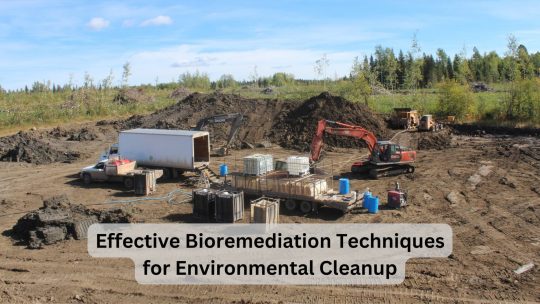
Effective Bioremediation Techniques: A Sustainable Solution for Environmental Cleanup
Bioremediation is a sustainable and cost-effective solution to environmental pollution, using living organisms such as bacteria and fungi to degrade pollutants into harmless compounds. There are various bioremediation techniques, including in situ (at the site of pollution) and ex situ (removing contaminants to treat elsewhere). Other methods include bioventing, biosparging, and use of bioreactors to promote the natural degradation of pollutants.
These techniques can handle a wide array of pollution types including petroleum, heavy metal, pesticide contamination, industrial waste, and landfill leachate. Benefits of bioremediation include its sustainability, cost-effectiveness, versatility, and non-invasiveness.
One company leading the way in bioremediation is Delta Remediation, based in Alberta, Canada. They specialize in applying these techniques to sites polluted with hydrocarbons, pesticides, and industrial waste, and have expanded their operations to Nigeria and Kenya.
Bioremediation thus offers a promising method for environmental cleanup, being both eco-friendly and adaptable to diverse environments. Companies like Delta Remediation are pioneering in this sector, making significant contributions to environmental health.
#Bioremediation techniques#Environmental cleanup#Sustainable solutions#Microorganisms in bioremediation#In situ bioremediation#Ex situ bioremediation#Bioventing for soil remediation#Biosparging for groundwater cleanup#Bioreactors in environmental remediation#Petroleum contamination cleanup#Heavy metal pollution remediation#Pesticide degradation#Industrial waste treatment#Landfill leachate remediation#Benefits of bioremediation#Delta Remediation#Bioremediation company#Alberta bioremediation services#Oil and gas industry cleanup#Hydrocarbon and pesticide decontamination
0 notes
Text
Generative AI Is Poised to Worsen the E-Waste Crisis
Generative AI could saddle the planet with heaps more hazardous waste
Every time generative artificial intelligence drafts an e-mail or conjures up an image, the planet pays for it. Making two images can consume as much energy as charging a smartphone; a single exchange with ChatGPT can heat up a server so much that it requires a bottle’s worth of water to cool. At scale, these costs soar. By 2027, the global AI sector could annually consume as much electricity as the Netherlands, according to one recent estimate. And a new study in Nature Computational Science identifies another concern: AI’s outsize contribution to the world’s mounting heap of electronic waste. The study found that generative AI applications alone could add 1.2 million to five million metric tons of this hazardous trash to the planet by 2030, depending on how quickly the industry grows. Such a contribution would add to the tens of millions of tons of electronic products the globe discards annually. Cell phones, microwave ovens, computers and other ubiquitous digital products often contain mercury, lead or other toxins. When improperly discarded, they can contaminate air, water and soil. The United Nations found that in 2022 about 78 percent of the world’s e-waste wound up in landfills or at unofficial recycling sites, where laborers risk their health to scavenge rare metals.
[...]
Few countries mandate the proper disposal of e-waste, and those that do often fail to enforce their existing laws on it. Twenty-five U.S. states have e-waste management policies, but there is no federal law that requires electronics recycling. In February Democratic Senator Ed Markey of Massachusetts introduced a bill that would require federal agencies to study and develop standards for AI’s environmental impacts, including e-waste. But that bill, the Artificial Intelligence Environmental Impacts Act of 2024 (which has not passed the Senate), would not force AI developers to cooperate with its voluntary reporting system. Some companies, however, claim to be taking independent action. Microsoft and Google have pledged to reach net zero waste and net zero emissions respectively by 2030; this would likely involve reducing or recycling AI-related e-waste.
12 notes
·
View notes
Note
We may have a problem with the so-called fiancé, @artofdeductionbysholmes I lost sight of him…
Any update on the lab results? @artofdeductionbysholmes @mollyatthemorgue
The question is: did he disappear on his own terms, or was his disappearance forced?
And yes, I just received @mollyatthemorgue Molly's lab report. See below.
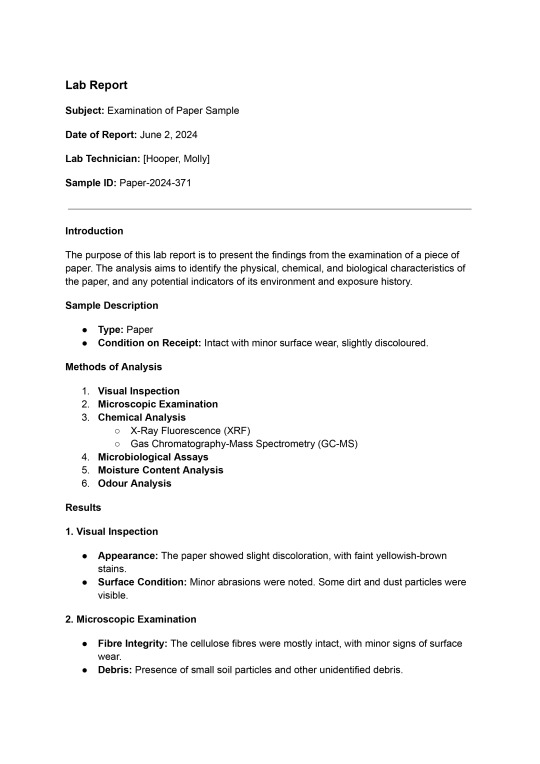

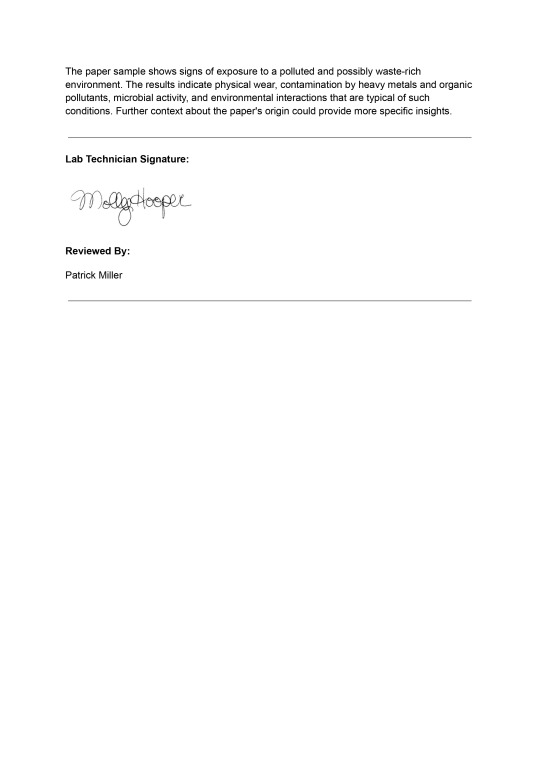
[ID: 3 screenshots of a lab report
Lab Report
Subject: Examination of Paper Sample
Date of Report: June 2, 2024
Lab Technician: Hooper, Molly
Sample ID: Paper-2024-371
Introduction
The purpose of this lab report is to present the findings from the examination of a piece of paper. The analysis aims to identify the physical, chemical, and biological characteristics of the paper, and any potential indicators of its environment and exposure history.
Sample Description
Type: Paper
Condition on Receipt: Intact with minor surface wear, slightly discoloured.
Methods of Analysis
Visual Inspection
Microscopic Examination
Chemical Analysis
X-Ray Fluorescence (XRF)
Gas Chromatography-Mass Spectrometry (GC-MS)
Microbiological Assays
Moisture Content Analysis
Odour Analysis
Results
1. Visual Inspection
Appearance: The paper showed slight discoloration, with faint yellowish-brown stains.
Surface Condition: Minor abrasions were noted. Some dirt and dust particles were visible.
2. Microscopic Examination
Fibre Integrity: The cellulose fibres were mostly intact, with minor signs of surface wear.
Debris: Presence of small soil particles and other unidentified debris.
3. Chemical Analysis
X-Ray Fluorescence (XRF):
Detected Elements: Trace amounts of heavy metals such as lead (Pb), cadmium (Cd), and chromium (Cr).
Surface Contaminants: Minor presence of inorganic substances.
Gas Chromatography-Mass Spectrometry (GC-MS):
Organic Compounds: Detected small amounts of hydrocarbons and other organic pollutants.
Residues: Identified residual chemicals from inks and dyes, with some degradation products.
4. Microbiological Assays
Bacterial Presence: Identified bacterial species including Bacillus and Pseudomonas spp.
Fungal Presence: Traces of fungal spores, likely Aspergillus and Penicillium spp.
5. Moisture Content Analysis
Moisture Level: Moderate moisture content of 12%.
Chemical Composition: The moisture contained slight acidic properties.
6. Odour Analysis
Detected Odours: Mild, musty odour with hints of organic decay.
Discussion
The examination of the paper sample indicates several key findings:
The physical condition and minor wear suggest it was exposed to an environment with abrasive materials and some physical stress.
The presence of heavy metals and organic pollutants detected by XRF and GC-MS indicates exposure to a polluted environment, potentially involving industrial or waste materials.
Microbial assays revealed early stages of microbial colonisation by bacteria and fungi typically associated with organic material decomposition.
The moderate moisture content and slight acidity suggest exposure to a moist environment with some chemical interactions.
Odour analysis confirmed the presence of organic decay-related gases.
The combination of physical wear, chemical contaminants, microbial presence, and environmental indicators suggests that the paper may have been exposed to a mixed waste or polluted environment. The findings are consistent with environments such as waste disposal sites, polluted industrial areas, or other locations with significant organic and inorganic contaminants.
Conclusion
The paper sample shows signs of exposure to a polluted and possibly waste-rich environment. The results indicate physical wear, contamination by heavy metals and organic pollutants, microbial activity, and environmental interactions that are typical of such conditions. Further context about the paper's origin could provide more specific insights.
Lab Technician Signature:
[signature of Molly Hooper]
Reviewed By:
Patrick Miller
/end ID]
22 notes
·
View notes
Text
Excerpt from this story from The Revelator:
The first time I visited Peehee Mu’huh, mining for lithium had already begun.
I was there in the fall of 2023 as part of my work with People of Red Mountain, descendants of the Fort McDermitt Paiute-Shoshone Tribe who lead the movement against extraction on this sacred landscape. We gathered at the valley in northern Nevada, known as Thacker Pass, to commemorate the massacre of 31 Paiute-Shoshone people there by the U.S. Cavalry on Sept. 12, 1865.
To dig up every pound of lithium, the mine will remove thousands of pounds of rock, soil, and other minerals, most of which will not be used and are considered waste.
That’s the secret of mining: It requires significant space to dump its byproducts.
Mine waste is no longer in the forefront for the environmental movement as it was when coal and nuclear power had their heyday, but it remains a key issue activists and scholars should be following. At Thacker Pass the 1,300 acres of wasteland will occupy the space indefinitely. Arsenic, antimony, and other hazards from the refining process to get lithium from the clay will pile up in this backfill pit and leach into the soils, watersheds, and air.
Historically miners have faced minimal oversight. Any individual could venture onto public lands and stake a claim to the minerals they contained — rights to occupy the land were established merely by proving a mineral’s presence and getting there first. Unlike loggers on public land, miners don’t pay any royalties; mine leases on public lands cost as little as $3 dollars per acre.
You might be forgiven for thinking this scenario sounds like something out of the 1800s prospector and ‘49ers era — and in fact, it is. Mining law was last meaningfully legislated under the 1872 General Mining Act.
Just as with the Black Hills gold rush in the Dakota Territory and those in Oregon and California, mine fervor during the gold and silver rushes that white settlers led on the red-colored mountains of Paiute-Shoshone lands in the 1850s-60s was violent and met by Indigenous resistance.
That resistance was crushed. Many noncombatants were killed and others forcibly displaced to Washington; the destruction continued for decades and hasn’t stopped yet.
Today the land base of the Paiute, Shoshone, and Bannock peoples of the area — collectively known as Atsawkoodakuh wyh Nuwu or Red Mountain Dwellers — is permeated by both abandoned and active mines. Gold and tungsten mining waned in the early to mid-1900s, but then companies started extracting uranium and mercury at the McDermitt and Cordero mines across the road from Fort McDermitt. According to Department of the Interior archives, this was the nation’s largest mercury mine from the 1930s to the 1970s. After the Cordero mine closed, crews spread arsenic-contaminated waste from the mine around the town and reservation as a fill dirt. The region was later declared a Superfund site, and the contaminants were removed between 2009 and 2013.
But the toxic waste caused decades of harm in the community before that removal. In a brazen environmental injustice, many Tribal members who worked there perished of cancer. Sunoco and Barrick Gold, the companies that exploited the quicksilver lode, simply “declined” the EPA’s order to clean up the area and escaped culpability.
Now the sacred landscape of Peehee Mu’huh will become the country’s largest lithium bounty.
A new bill before Congress aims to strip away even the baby-steps reform of Rosemont. The Mining Regulatory Clarity Act (HR2925) passed the House in May and awaits Senate approval (S1281). One would assume a bipartisan effort with such a name would offer progress, but the bill guts Rosemont by removing the requirement of claimants to prove minerals before using and dumping waste on public land.
A competing bill, the Green Energy Minerals Reform Act, would introduce requirements such as paying mineral royalties and funding cleanup — basic protections that should have already been in force. Congress held hearings about this proposed legislation in late 2023, but it has not moved forward since.
16 notes
·
View notes